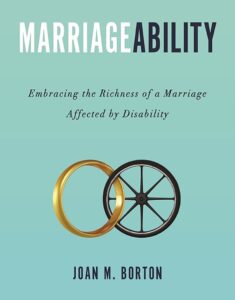© 2025 Joan M. Borton
The increased representation of people with disabilities in ads, television, movies, and books is encouraging. But some characters’ actions or words are contradictory to their disability.
Here are a few tips to consider:
• Know how your character became disabled. Were they born with it? Did they have an accident or illness that resulted in injury? People in each scenario respond to disability differently. Those born with a disability don’t know another way to live; it is their norm. For example, my mother often told my hubby, “I feel so sorry you have to sit all day.” He replied, “I don’t get what’s so great about standing. The few times I tried, it hurt.” People who acquire a disability later in life have to work through the emotional challenges that come with this dramatic life change. They often continue to approach life from a non-disabled point of view.
• Paraplegia and quadriplegia refer to the number of limbs affected by disability. Para means two. Quad refers to four. It doesn’t always indicate they are paralyzed or without feeling in those limbs.
• People who use wheelchairs are just that—people who use wheelchairs. Or you can identify them as wheelchair users. They are not wheelchair-bound. The wheelchair offers freedom and independence they may not otherwise have. They’re also not confined to a wheelchair. In the words of my husband, “I can fall out anytime I want to!”
• Don’t label a disabled person as an invalid. Want to know why? Pronounce it slowly, in-valid.
• Most people with physical disabilities don’t have hearing or cognitive disabilities. There is no need to have characters speak to them loudly or talk with simplified language unless you want to show the cluelessness of the speaker.
How can you best write a character with a disability? Get to know someone who lives with that condition in real life. Tell them what you’re doing and ask if they’ll help you develop the depth and richness of your character. But don’t just pepper them with questions. Get to know them as a friend. Do life together as your character might, e.g. attend a ballgame, movie, or restaurant. Observe how they manage the obstacles and note what makes their life easier.
Not only will your writing ring true, but you may just grow your platform as your friend shares your writing (loosely based on them) with others. Disabled people are a largely untapped audience waiting to be engaged!
_________________________

 Joan Borton writes about strengthening families affected by disability. Her twenty-nine years of experience comes from being married to Jerry, who was born with cerebral palsy. She is an active member of Word-Weavers International and WordGirls. She recently published MarriageAbility: Embracing the Richness of a Marriage Affected by Disability. Follow her on her website or at Luke14Exchange.org. When not caregiving or writing, jigsaw puzzles, and swimming are favorite activities. She and Jerry live in central Florida.
Joan Borton writes about strengthening families affected by disability. Her twenty-nine years of experience comes from being married to Jerry, who was born with cerebral palsy. She is an active member of Word-Weavers International and WordGirls. She recently published MarriageAbility: Embracing the Richness of a Marriage Affected by Disability. Follow her on her website or at Luke14Exchange.org. When not caregiving or writing, jigsaw puzzles, and swimming are favorite activities. She and Jerry live in central Florida.
